Dealing with car repairs after a collision can be a major inconvenience. Beyond the initial shock of the incident, you’re often left wondering about logistics: How will you get around? How much will it cost? And crucially, How Long Do Car Repairs Take? Not knowing the expected timeframe can add significantly to the stress of the situation.
For over two decades, at cars.edu.vn, we’ve dedicated ourselves to providing clear and helpful information about all aspects of car ownership and maintenance. We understand that unexpected repairs are a part of vehicle ownership, and our goal is to equip you with the knowledge you need to navigate these situations with confidence. This guide addresses the common question, “how long do car repairs take?” by outlining typical repair durations, the stages involved in the process, and the various factors that can influence the timeline. Understanding these elements will help you set realistic expectations and manage the repair process more smoothly.
Average Collision Repair Time
If you’re asking, “How long will my car be in the shop?”, the honest answer is: it depends. The duration of auto body repairs can fluctuate significantly, ranging from just a few hours to several weeks, or even longer in complex cases.
To give you a clearer picture of what to expect, we’ve compiled a table outlining average repair times based on the extent of the damage. Keep in mind these are estimates, and actual repair times can vary.
| Type of Collision Repair | Average Time to Fix |
|---|---|
| Minor Collision Repair | 1-3 days |
| Major Collision Repair | 1 to 3 weeks |
| Paintless Dent Repair | 1-2 days |
| Bumper Repair/Replacement | 1-3 days |
| Fender Repair/Replacement | 1-4 days |
| Door Repair/Replacement | 2-4 days |
| Glass Replacement | 1-2 days |
| Suspension Repair | 2-3 days |
| Frame Straightening | 4 days – 2 weeks |
| Paint Repair (minor) | 2-4 days |
| Paint Repair (major) | 1-2 weeks |
| Airbag Replacement | 2-5 days |
| Engine Repair/Replacement | 1-4 weeks |
| Full Vehicle Restoration | 4-8 weeks or longer |


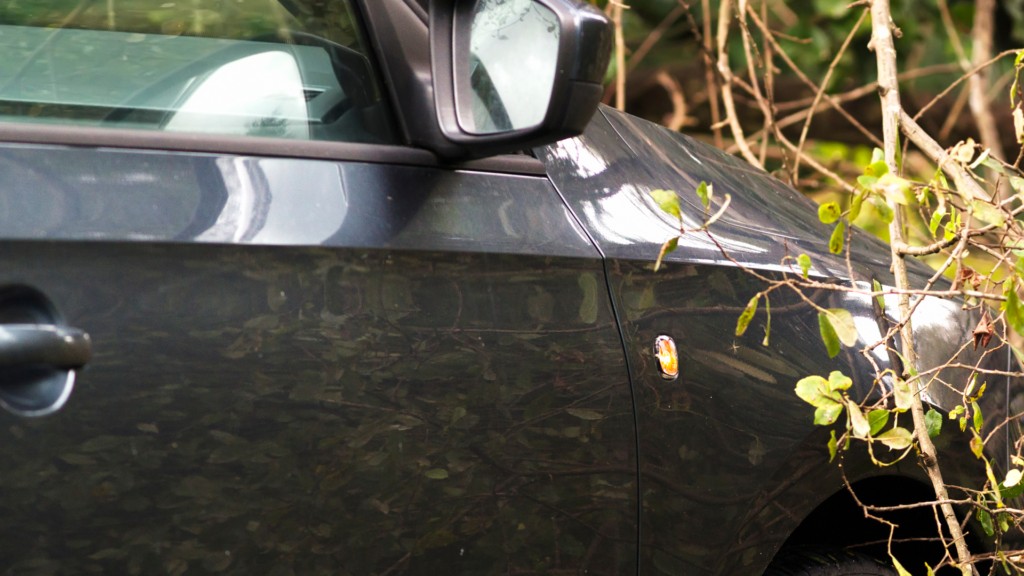
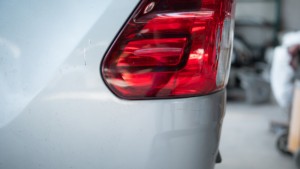

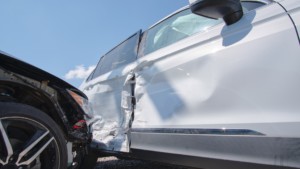
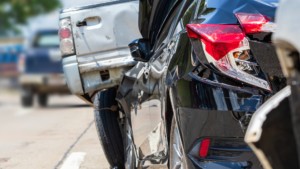
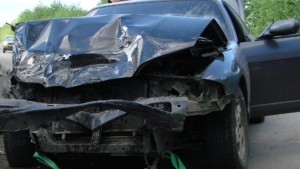


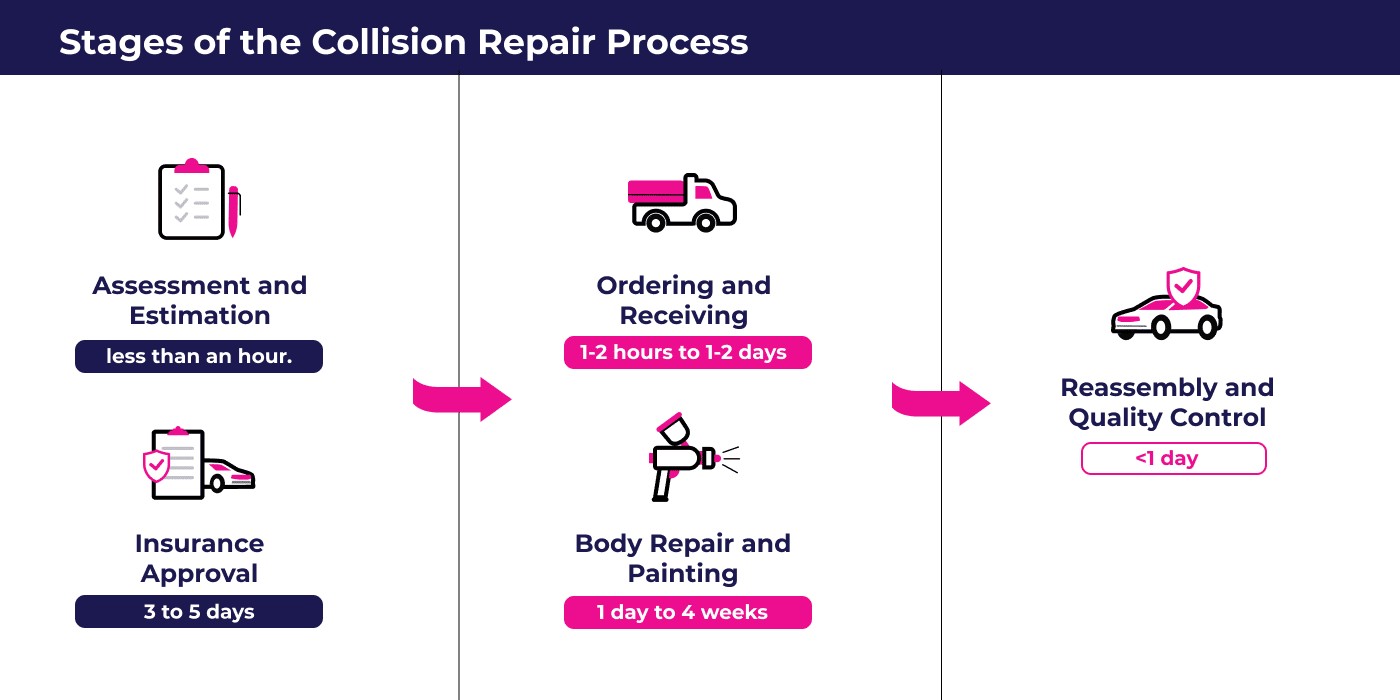
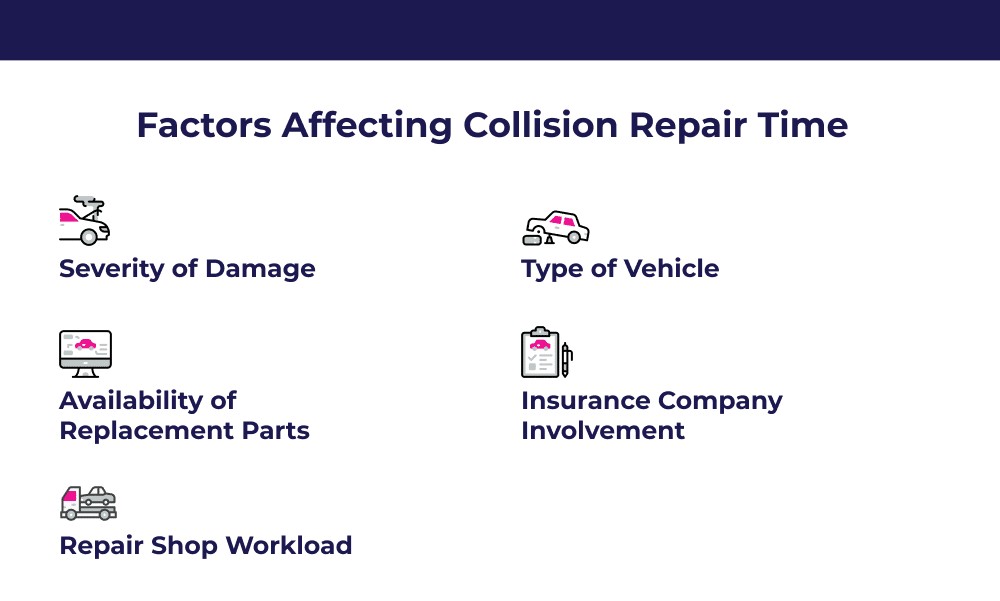
Minor vs. Major Collision Repair Times
The distinction between minor and major collision repair is crucial in understanding the expected timeframe.
Minor Collision Repair
Minor collision repairs typically take between 1 to 3 days. These types of repairs address superficial damage such as small dents, scratches, or minor bumper scrapes.
The speed of these repairs is due to their non-invasive nature. They generally don’t impact the vehicle’s structural integrity and primarily involve cosmetic fixes. These jobs are often less labor-intensive, and with readily available tools and parts, the actual repair work can frequently be completed within a few hours.
Examples of Minor Collision Repair:
- Shopping Cart Dent
- Tree Branch Scratches
- Minor Scratches from Road Debris
Major Collision Repair
In contrast, major collision repairs can extend from 1 to 3 weeks. These repairs tackle more significant damage, including frame damage, mechanical issues, or airbag deployments. The extended timeframe is due to the complexity of the work involved, the need for specialized equipment, and potentially waiting for specific parts.
Examples of Major Collision Repair:
- Rear-End Collision
- Side-Impact (T-Bone) Collision
- Parking Lot Collision with a Pole or Barrier
Severe Collision Damage
For cases involving severe damage, such as extensive frame damage or the requirement for rare or back-ordered parts, repair times can exceed 3 weeks. Generally, the more extensive the damage, the longer your vehicle will be in the repair shop.
Examples of Severe Collision Damage:
- High-Speed Head-On Collision
- Rollover Accident
- Severe Side-Impact (T-Bone) Collision at High Speed
Stages of the Collision Repair Process
Understanding the stages of the collision repair process can provide valuable insight into the overall timeframe, from the initial assessment to the moment you get your keys back.
Assessment and Estimation
The first step in any collision repair is a thorough assessment and estimate. A qualified repair technician will examine your vehicle’s damage, determine the necessary repairs, estimate the time and cost involved, document everything with photos and paperwork, and then provide you with a detailed repair estimate.
Typical Timeframe: While some shops might take a day or more to prepare a comprehensive estimate, many modern facilities, like cars.edu.vn partners, offer quicker estimate services, sometimes within an hour.
Insurance Approval
If you are filing an insurance claim for the repairs, the insurance company will need to review and approve the repair estimate. This might involve some negotiation regarding the proposed repairs, costs, and other details. The insurance company needs to verify if the vehicle is repairable and if the repair costs are reasonable, which can add time to the process.
Typical Timeframe: 3 to 5 business days, potentially longer depending on the insurance company’s processes and complexity of the claim.
Ordering and Receiving Parts (if needed)
Depending on the damage severity, your car’s make and model, and the specific areas affected, the repair shop may need to order replacement parts. The time to procure parts can vary from a few hours to several days, depending on the type of part, its availability, and the supplier’s location.
Typical Timeframe: 1-2 hours to 1-2 days, potentially longer for rare or specialty parts.
Body Repair and Painting
This is the core of the repair process. It involves restoring your vehicle to its pre-accident condition, ensuring structural integrity and factory specifications are met. This stage includes dent removal, panel replacement, frame straightening if needed, and meticulous paintwork to match the original finish.
Typical Timeframe: 1 day to 4 weeks, heavily dependent on the extent of damage and the complexity of the repairs.
Reassembly and Quality Control
Once the structural and cosmetic repairs are complete, the vehicle is reassembled. This includes reinstalling trim pieces, moldings, and any other components that were removed. Following reassembly, a thorough quality control inspection is performed. This ensures all repairs meet high standards, all vehicle systems are functioning correctly, and the car is safe to drive. The vehicle is also typically washed and detailed at this stage.
Typical Timeframe: Less than 1 day.
Additional Factors to Consider
Beyond these standard stages, unforeseen issues can arise. Hidden damage might be discovered during the repair process, requiring additional work. Some vehicles might need specialized repairs like frame straightening, wheel alignment, or advanced diagnostics, all of which can add to the repair timeline. External factors like supply chain disruptions or a high workload at the repair shop can also contribute to delays. Understanding these potential variables helps in anticipating a realistic repair duration.
Factors Affecting Collision Repair Time
Several key factors influence the answer to “How long does it take to fix my car?”. These include the nature of the damage, the availability of parts, the type of vehicle, insurance involvement, and the repair shop’s workload.
Severity of Damage
The extent of the damage is a primary determinant of both repair cost and time. Minor damage, like dents and scratches, is quicker and less expensive to fix, typically ranging from $150 to $2,000. Major damage, such as frame or bumper damage, can escalate costs to $30,000 or more. While minor repairs can be completed in hours, major repairs can take days or weeks. Very quick fixes, like buffing out a scratch, might only take an hour.
Availability of Replacement Parts
Parts availability significantly impacts both cost and repair time. Common parts are generally less expensive ($100 to $3,000) and readily available, allowing for quick repairs within a few hours to a couple of days.
However, rare or custom parts are more expensive, potentially exceeding $5,000, and can take days or even weeks to obtain. This delay not only increases the overall cost but also extends the repair time, as work cannot proceed until the necessary parts arrive.
The choice between OEM (Original Equipment Manufacturer) parts and aftermarket parts also plays a role. OEM parts, while ensuring quality and fit, can sometimes be back-ordered due to high demand or limited production. Aftermarket parts are generally more accessible but might not always meet OEM standards, potentially affecting long-term durability. Decisions regarding part sourcing and potential backorders can add complexity to both repair costs and timelines.
Type of Vehicle
The type of vehicle significantly influences repair costs and timelines. Common vehicles, including popular brands like Toyota, Honda, Ford, and Chevrolet, typically have readily available aftermarket and OEM parts. This makes repairs faster and often more affordable, with costs generally ranging from $500 to $3,000 and repair times spanning just a few days.
In contrast, luxury or rare vehicles such as Mercedes-Benz, BMW, Audi, Lexus, and Tesla often require specialized parts and technicians trained in handling their unique features and technologies. Repairs for these brands can be considerably more expensive, frequently exceeding $5,000, and can take several weeks, especially if rare parts are needed.
Newer vehicles, across all brands, may sometimes experience quicker and more cost-effective repairs due to better parts availability and warranty coverage, which can reduce both time and expenses.
Insurance Company Involvement
Involving insurance in collision repairs often adds to the overall repair time due to claim processing and approval procedures. Minor repairs, often under $1,000, might be quicker and simpler to handle out-of-pocket. For larger repairs, where costs can range from $1,500 to $5,000 or more, insurance claims are usually necessary, but they can extend the repair timeline from days to weeks. Choosing a repair shop that has experience working with insurance companies can streamline this process.
Repair Shop Workload
The workload of the auto repair shop directly affects how quickly your vehicle can be repaired. A busy shop may lead to scheduling delays. Choosing a reputable collision repair shop is crucial, as they are more likely to provide quality workmanship, transparent pricing, and reliable communication throughout the repair process. While average collision repairs can cost between $1,500 to $5,000, and the repair time can range from a few days to a couple of weeks, the specific shop’s efficiency and workload will influence the final duration.
Conclusion
So, when you ask, “How long does a collision repair take?”, you now know that the answer isn’t simple. It can range from less than a day to several weeks, depending on a multitude of factors. Understanding the repair process and the elements that influence the timeline can help you navigate this potentially stressful experience with more realistic expectations.
While waiting for your car to be repaired might be inconvenient, remember that quality repairs take time. Patience is key. By choosing a reputable auto repair service and maintaining open communication, you can ensure a smoother, more efficient, and ultimately reliable collision repair process.
Average Collision Repair Time FAQs
What are my transportation options while my car is in the shop?
Being without your car can disrupt your daily routine. Fortunately, several transportation options are often available while your vehicle is undergoing collision repair. In many cases, your auto insurance policy may include rental car coverage. Check your policy details to see if this benefit is included.
Many repair shops also offer assistance with transportation. Some may provide loaner vehicles, shuttle services, or even help arrange rental cars. Inquire with your chosen repair shop about their transportation assistance options.
Is there a warranty on automotive repairs?
Yes, reputable auto repair shops typically offer warranties on their workmanship and the parts they install. These warranties provide peace of mind and protect you against defects or issues arising from the repair work. The specifics of warranties can vary, so it’s important to ask your repair shop about their warranty policy, including the duration and what it covers.
How does the repair time for a front-end collision compare to a rear-end collision?
While every accident is unique and repair times depend on specific damage, rear-end collisions are often quicker and less costly to repair than front-end collisions. The front of a vehicle is typically more complex, housing critical components like the engine, radiator, grill, hood, and windshield. Damage to these areas often requires more extensive and time-consuming repairs compared to the rear of the vehicle.
When is my car considered a total loss?
A car is typically considered a total loss, or “totaled,” when the cost of repairing the damage exceeds the vehicle’s market value, or in many cases, when repair costs approach around 70-75% of the car’s value. In these situations, the insurance company may declare the vehicle a total loss and offer you a settlement based on its pre-accident value, rather than paying for repairs. While you might still be able to repair a totaled vehicle, the insurance company will generally only cover up to the vehicle’s value, leaving any remaining repair costs to be paid out-of-pocket.
What should I do if the repairs are taking much longer than initially estimated?
If your car repairs are taking significantly longer than the initial estimate, the first step is to communicate directly with your auto body shop. Politely inquire about the reason for the delay. There might be a valid explanation, such as unforeseen damage discovered during the repair process, delays in parts delivery, or complexities with the insurance claim. Open communication can often resolve misunderstandings and provide clarity.
If you are not satisfied with the explanation or if communication with the repair shop is unproductive, you can consider contacting your insurance company, especially if they are involved in the claim. Your insurance adjuster may be able to intervene or offer guidance. However, switching repair shops mid-repair can sometimes complicate matters further, particularly if the delay is related to parts availability or insurance claim issues that would affect any shop. It’s usually best to first understand the cause of the delay by communicating with your current repair shop.
How much does collision repair typically cost?
Just like the repair timeline, collision repair costs can vary widely based on numerous factors, including the severity of damage, the type of vehicle, parts costs, and labor rates. Due to this variability, obtaining a detailed estimate specific to your vehicle’s damage is essential. Many repair shops offer free estimates to help you understand potential costs. Contacting a reputable repair shop for a free estimate is the best way to determine the likely cost of your collision repairs and to plan your transportation and budget accordingly.